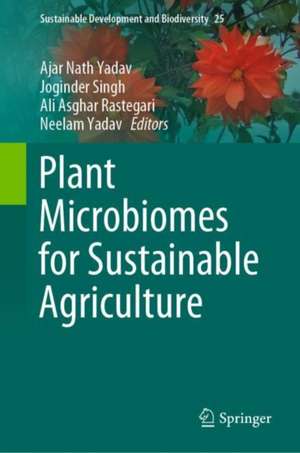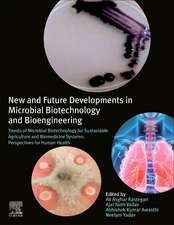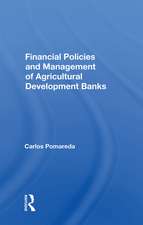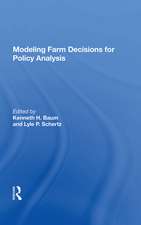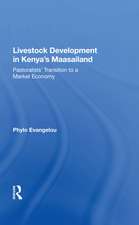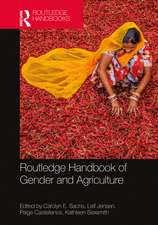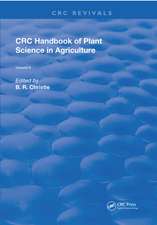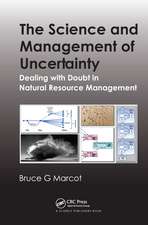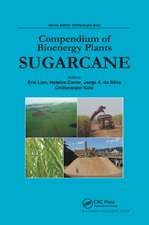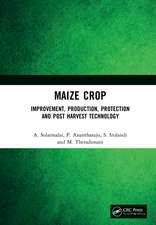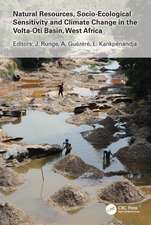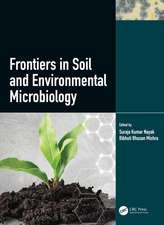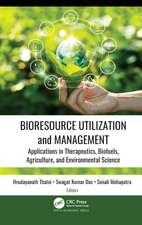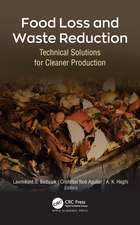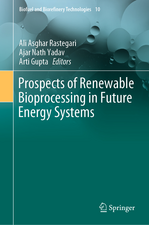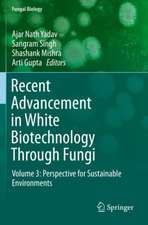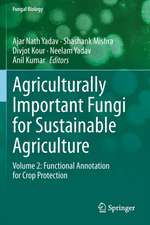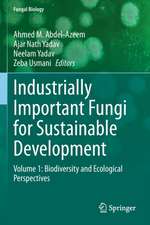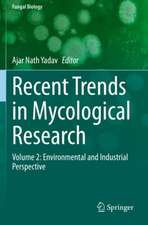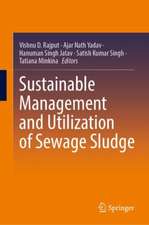Plant Microbiomes for Sustainable Agriculture: Sustainable Development and Biodiversity, cartea 25
Editat de Ajar Nath Yadav, Joginder Singh, Ali Asghar Rastegari, Neelam Yadaven Limba Engleză Hardback – 7 mar 2020
This book encompasses the current knowledge of plant microbiomes and their potential biotechnological application for plant growth, crop yield and soil health for sustainable agriculture. The plant microbiomes (rhizospheric, endophytic and epiphytic) play an important role in plant growth, development, and soil health. Plant and rhizospheric soil are a valuable natural resource harbouring hotspots of microbes, and it plays critical roles in the maintenance of global nutrient balance and ecosystem function. The diverse group of microbes is key components of soil–plant systems, where they are engaged in an intense network of interactions in the rhizosphere/endophytic/phyllospheric. The rhizospheric microbial diversity present in rhizospheric zones has a sufficient amount of nutrients release by plant root systems in form of root exudates for growth, development and activities of microbes. The endophytic microbes are referred to those microorganisms, which colonize in the interior ofthe plant parts, viz root, stem or seeds without causing any harmful effect on host plant. Endophytic microbes enter in host plants mainly through wounds, naturally occurring as a result of plant growth, or through root hairs and at epidermal conjunctions. Endophytes may be transmitted either vertically (directly from parent to offspring) or horizontally (among individuals). The phyllosphere is a common niche for synergism between microbes and plant. The leaf surface has been termed as phyllosphere and zone of leaves inhabited by microorganisms as phyllosphere. The plant part, especially leaves, is exposed to dust and air currents resulting in the establishments of typical flora on their surface aided by the cuticles, waxes and appendages, which help in the anchorage of microorganisms. The phyllospheric microbes may survive or proliferate on leaves depending on extent of influences of material in leaf diffuseness or exudates. The leaf diffuseness contains the principal nutrients factors (amino acids, glucose, fructose and sucrose), and such specialized habitats may provide niche for nitrogen fixation and secretions of substances capable of promoting the growth of plants.
The microbes associated with plant as rhizospheric, endophytic and epiphytic with plant growth promoting (PGP) attributes have emerged as an important and promising tool for sustainable agriculture. PGP microbes promote plant growth directly or indirectly, either by releasing plant growth regulators; solubilization of phosphorus, potassium and zinc; biological nitrogen fixation or by producing siderophore, ammonia, HCN and other secondary metabolites which are antagonistic against pathogenic microbes. The PGP microbes belong to different phylum of archaea (Euryarchaeota); bacteria (Acidobacteria, Actinobacteria, Bacteroidetes, Deinococcus-Thermus, Firmicutes and Proteobacteria) and fungi (Ascomycota and Basidiomycota), which include different genera namely Achromobacter,Arthrobacter, Aspergillus, Azospirillum, Azotobacter, Bacillus, Beijerinckia, Burkholderia, Enterobacter, Erwinia, Flavobacterium, Gluconoacetobacter, Haloarcula, Herbaspirillum, Methylobacterium, Paenibacillus, Pantoea, Penicillium, Piriformospora, Planomonospora, Pseudomonas, Rhizobium, Serratia and Streptomyces. These PGP microbes could be used as biofertilizers/bioinoculants at place of chemical fertilizers for sustainable agriculture.
The aim of “Plant Microbiomes for Sustainable Agriculture” is to provide the current developments in the understanding of microbial diversity associated with plant systems in the form of rhizospheric, endophytic and epiphytic. The book is useful to scientist, research and students related to microbiology, biotechnology, agriculture, molecular biology, environmental biology and related subjects.
Din seria Sustainable Development and Biodiversity
- 18%
 Preț: 962.18 lei
Preț: 962.18 lei - 18%
 Preț: 953.03 lei
Preț: 953.03 lei - 18%
 Preț: 952.09 lei
Preț: 952.09 lei - 18%
 Preț: 1563.72 lei
Preț: 1563.72 lei - 18%
 Preț: 1219.63 lei
Preț: 1219.63 lei - 18%
 Preț: 1572.88 lei
Preț: 1572.88 lei - 24%
 Preț: 796.33 lei
Preț: 796.33 lei - 24%
 Preț: 1564.50 lei
Preț: 1564.50 lei - 18%
 Preț: 1412.20 lei
Preț: 1412.20 lei - 18%
 Preț: 1669.03 lei
Preț: 1669.03 lei - 18%
 Preț: 955.08 lei
Preț: 955.08 lei - 24%
 Preț: 824.66 lei
Preț: 824.66 lei - 24%
 Preț: 824.15 lei
Preț: 824.15 lei - 24%
 Preț: 1052.06 lei
Preț: 1052.06 lei - 24%
 Preț: 900.85 lei
Preț: 900.85 lei - 24%
 Preț: 903.56 lei
Preț: 903.56 lei - 18%
 Preț: 1391.97 lei
Preț: 1391.97 lei - 15%
 Preț: 646.11 lei
Preț: 646.11 lei - 15%
 Preț: 645.60 lei
Preț: 645.60 lei - 24%
 Preț: 794.73 lei
Preț: 794.73 lei - 15%
 Preț: 705.51 lei
Preț: 705.51 lei - 24%
 Preț: 786.67 lei
Preț: 786.67 lei - 24%
 Preț: 983.36 lei
Preț: 983.36 lei - 18%
 Preț: 1559.80 lei
Preț: 1559.80 lei - 18%
 Preț: 1398.14 lei
Preț: 1398.14 lei - 18%
 Preț: 1416.47 lei
Preț: 1416.47 lei - 18%
 Preț: 1575.88 lei
Preț: 1575.88 lei - 18%
 Preț: 1400.50 lei
Preț: 1400.50 lei - 18%
 Preț: 953.20 lei
Preț: 953.20 lei - 20%
 Preț: 578.05 lei
Preț: 578.05 lei - 24%
 Preț: 820.37 lei
Preț: 820.37 lei - 20%
 Preț: 583.95 lei
Preț: 583.95 lei
Preț: 1133.34 lei
Preț vechi: 1382.12 lei
-18% Nou
Puncte Express: 1700
Preț estimativ în valută:
216.89€ • 225.60$ • 179.06£
216.89€ • 225.60$ • 179.06£
Carte disponibilă
Livrare economică 24 martie-07 aprilie
Preluare comenzi: 021 569.72.76
Specificații
ISBN-13: 9783030384524
ISBN-10: 3030384527
Pagini: 482
Ilustrații: XXIII, 482 p. 57 illus., 46 illus. in color.
Dimensiuni: 155 x 235 x 33 mm
Greutate: 1.15 kg
Ediția:1st ed. 2020
Editura: Springer International Publishing
Colecția Springer
Seria Sustainable Development and Biodiversity
Locul publicării:Cham, Switzerland
ISBN-10: 3030384527
Pagini: 482
Ilustrații: XXIII, 482 p. 57 illus., 46 illus. in color.
Dimensiuni: 155 x 235 x 33 mm
Greutate: 1.15 kg
Ediția:1st ed. 2020
Editura: Springer International Publishing
Colecția Springer
Seria Sustainable Development and Biodiversity
Locul publicării:Cham, Switzerland
Cuprins
Chapter 1 - Diversity, Plant Growth Promotion Attributes and Agricultural Applications of Rhizospheric Microbes (Gangavarapu Subrahmanyam, Amit Kumar, Sosanka Protim Sandilya, Mahananda Chutia, Ajar Nath Yadav).- Chapter 2 - Culturable Endophytic Fungal Communities Associated with Cereal Crops and their Role in Plant Growth Promotion(Hira Saleem, Hareem Mohsin, Rabia Tanvir, Yasir Rehman).- Chapter 3 - Current Perspectives on Phosphate Solubilizing Endophytic Fungi: Ecological Significances and Biotechnological Applications (Edla Sujatha, Kuraganti Gunaswetha, Pallaval Veera Bramhachari).- Chapter 4 - Endophytic Microbes from Medicinal Plants and Their Secondary Metabolites for Agricultural Significances (Chanda V. Parulekar Berde, Prachiti. P. Rawool, Pallaval Veera Bramhachari, Vikrant B. Berde).- Chapter 5 - Phyllospheric Microbiomes: Diversity, Ecological Significance, and Biotechnological Applications (Natesan Sivakumar, Ramamoorthy Sathish Kumar, Gopal Selvakumar, Rajaram Shyamkumar and Kalimuthu Arjune Kumar).- Chapter 6 - Biofilms Forming Microbes: Diversity and Potential Application in Plant-Microbe Interaction and Plant Growth (Ajay Kumar and Joginder Singh).- Chapter 7 - Actinobacteria: Diversity, Plant Interactions and Biotechnology Applications (Monnanda Somaiah Nalini, and Harischandra Sripathy Prakash).- Chapter 8 - Phylogenetic Diversity of Epiphytic Pink-Pigmented Methylotrophic Bacteria and Role in Alleviation of Abiotic Stress in Plants (Ganapathy Ashok, Guruvu Nambirajan, Krishnan Baskaran, chandran Viswanathan and Xavier Alexander).- Chapter 9 - Potassium Solubilizing Microbes: Diversity, Ecological Significances and Biotechnological Applications (Dheeraj Pandey, Ifra Zoomi, Harbans Kaur Kehri, Uma Singh, Kanhaiya L. Chaudhri and Ovaid Akhtar).- Chapter 10 - Alleviation of Stress–Induced Ethylene–Mediated Negative Impact on Crop Plants by Bacterial ACC Deaminase: Perspectives and Applications in Stressed Agriculture Management (Hassan Etesami, Fatemeh Noori, Ali Ebadi, Narges Reiahi Samani).- Chapter 11 - Halophilic Microbes from Plant Growing Under the Hypersaline Habitats and Their Application for Plant Growth and Mitigation of Salt Stress (Jai Prakash, Enespa , Prem Chandra).- Chapter 12 - Microbes Mediated Drought Tolerance in Plants: Current Developments and Future Challenges (Iti Gontia-Mishra, Swapnil Sapre, Reena Deshmukh, Sumana Sikdar and Sharad Tiwari).- Chapter 13 - Microbial Consortium as Biofertilizers for Crops Growing Under the Extreme Habitats (Chuks Kenneth Odoh, Kabari Sam, Nenibarini Zabbey, Chibuzor Nwadibe Eze, Amechi S. Nwankwegu, Charity Laku and Boniface Barinem Dumpe).- Chapter 14 - Global Scenario of Plant Microbiome for Sustainable Agriculture: Current Advancements and Future Challenges (Simranjeet Singh, Vijay Kumar, Satyender Singh, Daljeet SinghDhanjal, Shivika Datta and Joginder Singh).- Chapter 15 - Current Aspects and Application of Biofertilizers for Sustainable Agriculture (Modhurima Misra, Ashish Sachan, Shashwati Ghosh Sachan).- Chapter 16 - Plant Microbiomes for Sustainable Agriculture: Conclusion and Future Vision (Ajar Nath Yadav).
Textul de pe ultima copertă
This book encompasses the current knowledge of plant microbiomes and their potential biotechnological application for plant growth, crop yield and soil health for sustainable agriculture. The plant microbiomes (rhizospheric, endophytic and epiphytic) play an important role in plant growth, development, and soil health. Plant and rhizospheric soil are a valuable natural resource harbouring hotspots of microbes, and it plays critical roles in the maintenance of global nutrient balance and ecosystem function. The diverse group of microbes is key components of soil–plant systems, where they are engaged in an intense network of interactions in the rhizosphere/endophytic/phyllospheric. The rhizospheric microbial diversity present in rhizospheric zones has a sufficient amount of nutrients release by plant root systems in form of root exudates for growth, development and activities of microbes. The endophytic microbes are referred to those microorganisms, which colonize in the interior ofthe plant parts, viz root, stem or seeds without causing any harmful effect on host plant. Endophytic microbes enter in host plants mainly through wounds, naturally occurring as a result of plant growth, or through root hairs and at epidermal conjunctions. Endophytes may be transmitted either vertically (directly from parent to offspring) or horizontally (among individuals). The phyllosphere is a common niche for synergism between microbes and plant. The leaf surface has been termed as phyllosphere and zone of leaves inhabited by microorganisms as phyllosphere. The plant part, especially leaves, is exposed to dust and air currents resulting in the establishments of typical flora on their surface aided by the cuticles, waxes and appendages, which help in the anchorage of microorganisms. The phyllospheric microbes may survive or proliferate on leaves depending on extent of influences of material in leaf diffuseness or exudates. The leaf diffuseness contains the principal nutrients factors (amino acids, glucose, fructose and sucrose), and such specialized habitats may provide niche for nitrogen fixation and secretions of substances capable of promoting the growth of plants.
Caracteristici
Is devoted to utilization of beneficial plant microbiomes (rhizospheric, endophytic, and epiphytic) with multifunctional plant growth promoting attributes for sustainable developments Contains the scientific achievements made so far on microbial biotechnology of plant-associated microbiomes Seems unique in its kind Presents chapters written by eminent experts of related subjects from different countries
